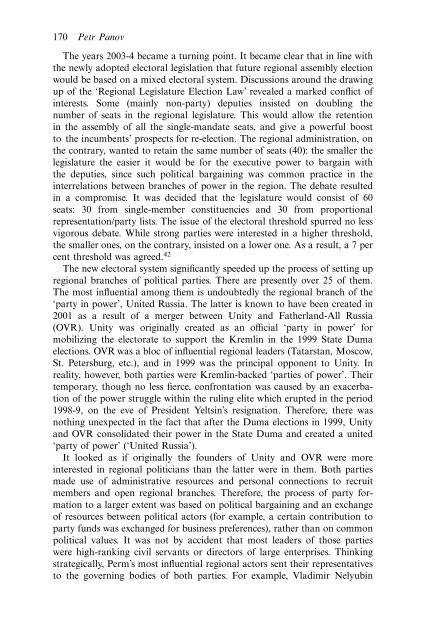Federalism and Local Politics in Russia
Federalism and Local Politics in Russia
Federalism and Local Politics in Russia
Create successful ePaper yourself
Turn your PDF publications into a flip-book with our unique Google optimized e-Paper software.
170 Petr PanovThe years 2003-4 became a turn<strong>in</strong>g po<strong>in</strong>t. It became clear that <strong>in</strong> l<strong>in</strong>e withthe newly adopted electoral legislation that future regional assembly electionwould be based on a mixed electoral system. Discussions around the draw<strong>in</strong>gup of the ‘Regional Legislature Election Law’ revealed a marked conflict of<strong>in</strong>terests. Some (ma<strong>in</strong>ly non-party) deputies <strong>in</strong>sisted on doubl<strong>in</strong>g thenumber of seats <strong>in</strong> the regional legislature. This would allow the retention<strong>in</strong> the assembly of all the s<strong>in</strong>gle-m<strong>and</strong>ate seats, <strong>and</strong> give a powerful boostto the <strong>in</strong>cumbents’ prospects for re-election. The regional adm<strong>in</strong>istration, onthe contrary, wanted to reta<strong>in</strong> the same number of seats (40): the smaller thelegislature the easier it would be for the executive power to barga<strong>in</strong> withthe deputies, s<strong>in</strong>ce such political barga<strong>in</strong><strong>in</strong>g was common practice <strong>in</strong> the<strong>in</strong>terrelations between branches of power <strong>in</strong> the region. The debate resulted<strong>in</strong> a compromise. It was decided that the legislature would consist of 60seats: 30 from s<strong>in</strong>gle-member constituencies <strong>and</strong> 30 from proportionalrepresentation/party lists. The issue of the electoral threshold spurred no lessvigorous debate. While strong parties were <strong>in</strong>terested <strong>in</strong> a higher threshold,the smaller ones, on the contrary, <strong>in</strong>sisted on a lower one. As a result, a 7 percent threshold was agreed. 42The new electoral system significantly speeded up the process of sett<strong>in</strong>g upregional branches of political parties. There are presently over 25 of them.The most <strong>in</strong>fluential among them is undoubtedly the regional branch of the‘party <strong>in</strong> power’, United <strong>Russia</strong>. The latter is known to have been created <strong>in</strong>2001 as a result of a merger between Unity <strong>and</strong> Fatherl<strong>and</strong>-All <strong>Russia</strong>(OVR). Unity was orig<strong>in</strong>ally created as an official ‘party <strong>in</strong> power’ formobiliz<strong>in</strong>g the electorate to support the Kreml<strong>in</strong> <strong>in</strong> the 1999 State Dumaelections. OVR was a bloc of <strong>in</strong>fluential regional leaders (Tatarstan, Moscow,St. Petersburg, etc.), <strong>and</strong> <strong>in</strong> 1999 was the pr<strong>in</strong>cipal opponent to Unity. Inreality, however, both parties were Kreml<strong>in</strong>-backed ‘parties of power’. Theirtemporary, though no less fierce, confrontation was caused by an exacerbationof the power struggle with<strong>in</strong> the rul<strong>in</strong>g elite which erupted <strong>in</strong> the period1998-9, on the eve of President Yelts<strong>in</strong>’s resignation. Therefore, there wasnoth<strong>in</strong>g unexpected <strong>in</strong> the fact that after the Duma elections <strong>in</strong> 1999, Unity<strong>and</strong> OVR consolidated their power <strong>in</strong> the State Duma <strong>and</strong> created a united‘party of power’ (‘United <strong>Russia</strong>’).It looked as if orig<strong>in</strong>ally the founders of Unity <strong>and</strong> OVR were more<strong>in</strong>terested <strong>in</strong> regional politicians than the latter were <strong>in</strong> them. Both partiesmade use of adm<strong>in</strong>istrative resources <strong>and</strong> personal connections to recruitmembers <strong>and</strong> open regional branches. Therefore, the process of party formationto a larger extent was based on political barga<strong>in</strong><strong>in</strong>g <strong>and</strong> an exchangeof resources between political actors (for example, a certa<strong>in</strong> contribution toparty funds was exchanged for bus<strong>in</strong>ess preferences), rather than on commonpolitical values. It was not by accident that most leaders of those partieswere high-rank<strong>in</strong>g civil servants or directors of large enterprises. Th<strong>in</strong>k<strong>in</strong>gstrategically, Perm’s most <strong>in</strong>fluential regional actors sent their representativesto the govern<strong>in</strong>g bodies of both parties. For example, Vladimir Nelyub<strong>in</strong>
















